VFX house produced 417 shots for BBC Studios Science Unit production
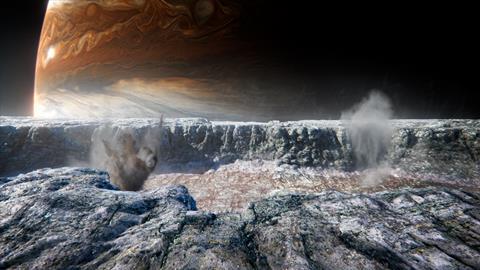
Lux Aeterna has revealed the work that went into the VFX for BBC2 series Solar System.
Released on 7 October 2024 and now available on iPlayer, the show aims to look at solar system in a way that hasn’t been done before, showing viewers epic vistas inside Jupiter’s electric storm clouds, flying through Europa’s crumbling ice canyons, witnessing ‘never seen before’ superionic ice on Uranus, enormous dust storms covering Mars, seas and lakes filled with liquid methane on Saturn’s largest moon, Titan, and exploring the deep caverns of Miranda, as we follow a rock into the darkness on Uranus.
It was produced by the BBC Studios Science Unit, and executive produced by Gideon Bradshaw.
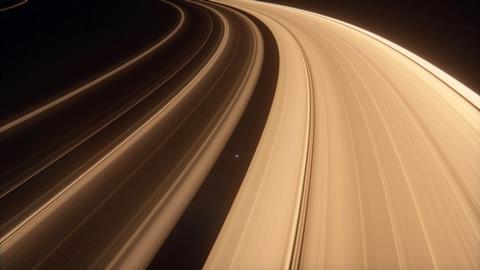
Lux Aeterna creative director Rob Hifle said: “Some of the planet’s surfaces have never been explored, so part of the challenge was to unpack the latest scientific data before we embarked on delivering the high-end photorealistic environments. To obtain this level of fidelity, it was imperative for the team of supervisors, Clive Llewellyn, Timmy Willmott, Tav Flett and Creative Lead Mike Sadd, to work closely to create an efficient pipeline incorporating Houdini, Maya, Gaea and ZBrush, all meticulously planned by Lux Aeterna’s executive VFX producer Emma Kolasinska.”
Creative lead Mike Sadd has no formal education in astrophysics, but a personal interest and working on the likes of 8 Days to the Moon and Back, Our Universe, and numerous Professor Brian Cox series over the past ten years assisted working on Solar System.
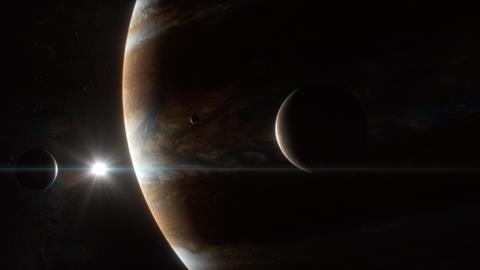
Hifle explained, “Mike brought a huge wealth of experience to Solar System, not just through his understanding of the subject matter but also through his storyboard and animatic skills. Mike was able to break down the full VFX requirements and determine where the best budget lay for making the show as cinematic as possible. Artistically, this saved a lot of time. Mike has detailed knowledge of the planets and was able to dictate the look more accurately as a result.”
An obstacle identified by Sadd included the colour of Neptune in the data provided by NASA. “Due to the age of the data, the original colours of Neptune hadn’t been processed correctly,” explained Sadd. “The visuals we received were more a pale blue, so we flagged this to BBC Studios and Tav’s team corrected it in comp.”
The brief resulted in full VFX for all five episodes of the series, including space and planetary shots, with 417 VFX shots in total. Most of these shots were full VFX builds, with a few additional composites utilising plates shot on location in Iceland, Portugal, and the United States. “Each environment had a different character,” says CG supervisor Timmy Willmott. “We worked closely with BBC Studios Science Unit, who liaised with researchers and scientific experts for each episode.”
Dust storms, collisions, and atmospheric effects were critical for creating realistic on-planet visuals for the series. For dust storms, fluid sims helped simulate large swirling clouds of sand and debris. Lux Aeterna’s FX artist Clive Llewellyn used procedural processes within Houdini to create vast amounts of bespoke cloud elements. “Procedural Dependency Graph allowed me to build a template which would in turn control the simulation and variation created via our render farm, as well as focus on an individual element before propagating the parameters, with variations added to things such as turbulence, velocity and divergence, into the supplementary tasks,” said Llewellyn.
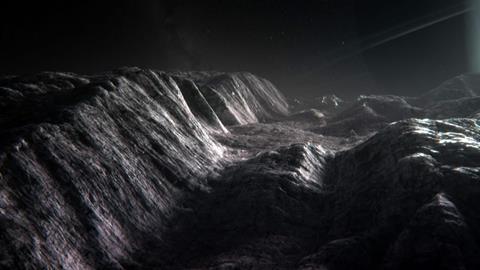
Many terabytes of data were used in the creation of these shots so planning was crucial, working closely with production and liaising with clients allowed Lux Aeterna to schedule these mammoth sims in and around other deliveries.
Asteroid collisions were designed with a focus on realistic impact physics and debris distribution. “The important aspect to deal with when working with astronomical simulations is capturing a sense of scale. A keen understanding of how large-scale objects behave in a vacuum is crucial,” elaborated Llewellyn. “Selling the scale of an impact all comes down to speed and size of debris. Using Houdini, we were able to create very high-resolution Rigid Body Dynamics (RBD) simulations, with complete control over the pre-fractured piece size, sub fractures and debris. Being able to dynamically visualise and control the size of said pieces before pushing this into a sim was very advantageous and ultimately saved us a lot of time in the initial builds.”
Being tasked with augmenting shot plate photography brought its own set of challenges for the FX department. Highly detailed fluid sims were required that needed to react and collide with the plate photography. Photogrammetry played a critical role and allowed Lux Aeterna to capture high-resolution 3D models of actual environments.

The FX team used this data to create collision geometry, physical representations of input terrain, for fluid simulations. This allowed the simulations to interact accurately with the surfaces created from the plates, ensuring the flip sims behaved naturally when colliding with objects or impacting the ground. “Once we created the collision sources we were able to reproject the plate over this new geometry collision source, allowing us to run very high resolution fluid and white water sims where the physics would be plausible,” continued Llewellyn. “This also had the added benefit of allowing the colours and details from the original plate to bleed into the transmission and reflectivity of the CG water, embedding the water into the shot and aiding photorealism.” Together, these techniques gave the series a highly detailed and authentic feel, aiming to make the interactions between natural phenomena and the environment believable.
There were lots of early discussions between Hifle and Bradshaw on how the shows were going to navigate seamlessly between the planets. The pair discussed the experience of leaving a planet, as if viewing the journey like you would through a car wing mirror, then arriving at a new planetary destination. “We felt that that hadn’t really been done before, and that was the challenge to Lux Aeterna to look at how can we actually do that?” said Bradshaw. “How can we take you from orbit and land you on the surface of these worlds? Boots on the ground to witness these incredible phenomena playing out.”
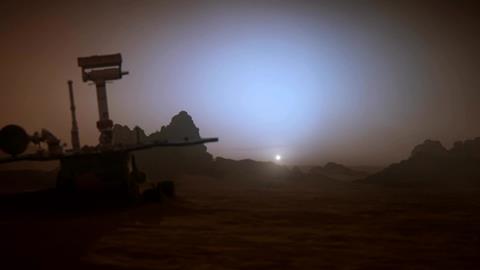
The final touches of the show were supplemented with motion graphics by the Lux Aeterna design dept. The team delivered a star map to guide viewers through the geography of the universe. “The orrery map helped with the understanding of the proximity between planets,” comments Sadd. “The visual went through several iterations and resulted in a diagrammatic graphic that guided and flowed through the solar system.”
When asked about the challenges of producing a series like Solar System, Bradshaw highlighted the demands associated with a global series of this kind and the challenges of making sure it is managed efficiently. “These series’ have an extremely high expectation that they need to really look fantastic, sound fantastic, work for a global audience […] I think, hopefully, we and Lux Aeterna have delivered on that,” he said.








No comments yet